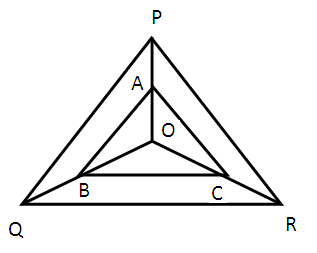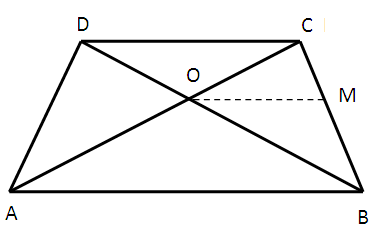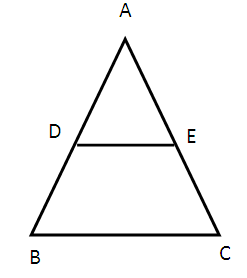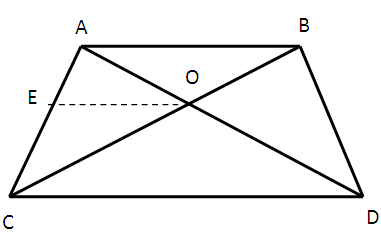CONVERSE OF BASIC PROPORTIONALITY THEOREM EXAMPLES
Example 1 :
In the figure given below, A, B and C are points on OP, OQ and OR respectively such that AB ∥ PQ and AC ∥ PR. Show that BC ∥ QR.

Solution :
In triangle OPQ,
Given that :
AB is parallel to PQ
OA/AP = OB/BQ ---(1)
In triangle OPR,
Given that :
AC is parallel to PR
OA/AP = OC/CR ---(2)
(1) = (2)
OB/BQ = OC/CR
Hence the sides BC and QR are parallel.
Example 2 :
ABCD is a trapezium in which AB || DC and its diagonals intersect each other at the point O. Show that AO/BO = OC/OD.
Solution :

Draw OM parallel to AB meeting BC at M.
In triangle ACB,
Given that :
OM is parallel to AB
OC/OA = CM/MB ----(1)
In triangle BDC,
OM is parallel to CD
BM/MC = OB/OD
By taking reciprocals on both sides, we get
CM/MB = OD/OB ----(2)
OC/OA = OD/OB
OC/OD = OA/OB
Hence proved.
Example 3 :
The diagonals of a quadrilateral ABCD intersect each other at the point O such that AO/BO = CO/OD. Show that ABCD is a trapezium
Solution :

AD = DB
AD/BD = 1 ---- (i)
Also, E is the mid-point of AC (Given)
AE = EC
AE/EC = 1 [From equation (i)]
From equation (i) and (ii), we get
AD/BD = AE/EC
By using the converse of basic proportionality theorem, the sides DE and BC are parallel.
Example 4 :
ABCD is a trapezium in which AB ∥ DC and its diagonals intersect each other at the point O. Show that (AO/BO) = (CO/DO)

In ΔADC, we have OE || DC
AE/ED = AO/CO ...(i)
In ΔABD, we have OE || AB
DE/EA = DO/BO ...(ii)
From equation (i) and (ii), we get
AO/CO = BO/DO
AO/BO = CO/DO
Kindly mail your feedback to v4formath@gmail.com
We always appreciate your feedback.
©All rights reserved. onlinemath4all.com
Recent Articles
-
Digital SAT Math Problems and Solutions (Part - 150)
Apr 25, 25 11:46 AM
Digital SAT Math Problems and Solutions (Part - 150) -
AP Calculus AB Problems with Solutions (Part - 19)
Apr 24, 25 11:10 PM
AP Calculus AB Problems with Solutions (Part - 19) -
AP Calculus AB Problems with Solutions (Part - 18)
Apr 24, 25 11:06 PM
AP Calculus AB Problems with Solutions (Part - 18)
